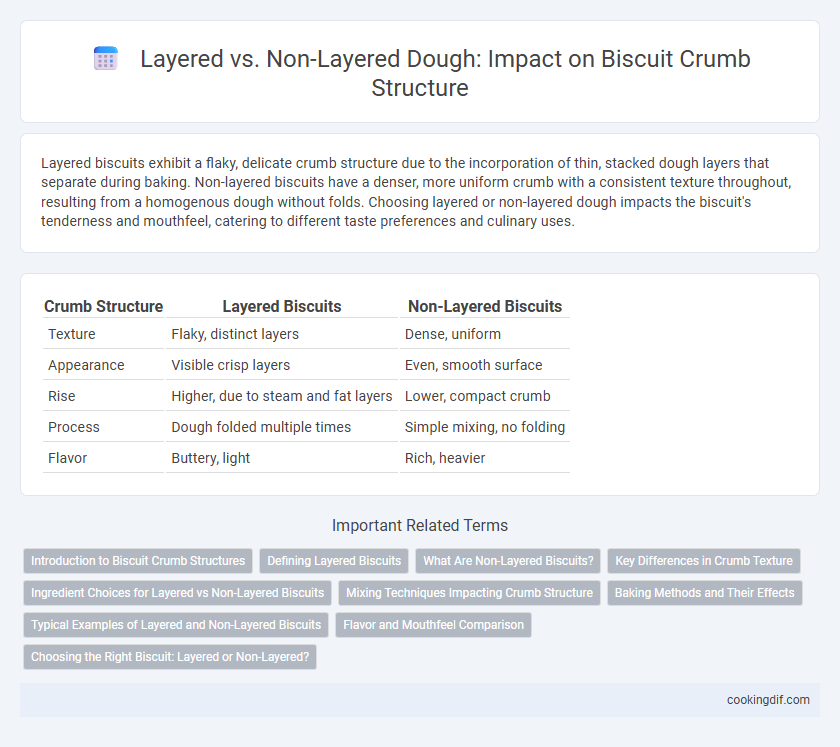Layered biscuits exhibit a flaky, delicate crumb structure due to the incorporation of thin, stacked dough layers that separate during baking. Non-layered biscuits have a denser, more uniform crumb with a consistent texture throughout, resulting from a homogenous dough without folds. Choosing layered or non-layered dough impacts the biscuit's tenderness and mouthfeel, catering to different taste preferences and culinary uses.
Table of Comparison
| Crumb Structure | Layered Biscuits | Non-Layered Biscuits |
|---|---|---|
| Texture | Flaky, distinct layers | Dense, uniform |
| Appearance | Visible crisp layers | Even, smooth surface |
| Rise | Higher, due to steam and fat layers | Lower, compact crumb |
| Process | Dough folded multiple times | Simple mixing, no folding |
| Flavor | Buttery, light | Rich, heavier |
Introduction to Biscuit Crumb Structures
Biscuit crumb structures vary significantly between layered and non-layered types, influencing texture and mouthfeel. Layered biscuits exhibit distinct, flaky layers caused by laminated dough techniques, resulting in a tender, airy crumb. Non-layered biscuits have a uniform, fine crumb structure achieved through homogeneous mixing, providing a denser and more consistent texture.
Defining Layered Biscuits
Layered biscuits feature distinct, airy layers achieved through dough folding techniques that create a flaky and tender crumb structure, enhancing texture and mouthfeel. This method contrasts with non-layered biscuits, which have a uniform, denser crumb due to simple mixing and baking processes without folding. The layered approach relies on butter or shortening incorporation and careful rolling to trap steam, promoting separation and rise during baking.
What Are Non-Layered Biscuits?
Non-layered biscuits feature a dense, uniform crumb structure without distinct layers, achieved by minimal folding or lamination during dough preparation. This type prioritizes a tender, moist texture with a consistent crumb, unlike layered biscuits which have flaky, airy layers formed by incorporating butter through multiple folds. Non-layered biscuits are ideal for those seeking a soft bite and a more bread-like interior, often preferred in southern-style biscuit recipes.
Key Differences in Crumb Texture
Layered biscuits exhibit a flaky, airy crumb structure due to multiple thin dough layers created by folding or laminating, resulting in a tender, crisp texture with distinct separation between layers. Non-layered biscuits have a denser, more uniform crumb, characterized by a soft, crumbly, and often more cake-like consistency without visible strata. The key difference lies in the formation process, where layering traps steam for lift and flakiness, while non-layered dough relies on chemical leaveners and mixing techniques to achieve softness and tenderness.
Ingredient Choices for Layered vs Non-Layered Biscuits
Layered biscuits rely on high-fat ingredients like butter or shortening to create distinct, flaky layers through steam release during baking, while non-layered biscuits emphasize uniform crumb structure achieved with balanced hydration and minimal mixing. Incorporating cold fat pieces in layered biscuit dough promotes separation between dough layers, whereas smooth incorporation of fat in non-layered biscuits contributes to a tender, consistent texture. Leavening agents such as baking powder are crucial in both, but careful ingredient ratios influence the rise and crumb differences between layered and non-layered biscuits.
Mixing Techniques Impacting Crumb Structure
Layered biscuits achieve a flaky, tender crumb structure through techniques such as lamination and folding, which create thin alternating layers of dough and fat that trap steam during baking. Non-layered biscuits rely on gentle mixing to incorporate air and evenly distribute leavening agents, resulting in a uniform, tender crumb without distinct layers. The mixing method directly influences gluten development and fat distribution, crucial factors determining the biscuit's final texture and crumb structure.
Baking Methods and Their Effects
Layered biscuits exhibit a flaky, tender crumb structure achieved through lamination techniques that incorporate butter or fat between dough folds, creating distinct layers during baking. Non-layered biscuits rely on a more homogeneous mixing method, resulting in a denser, crumbly texture with a uniform crumb. Baking temperature and time crucially influence the rise and texture; high heat promotes steam expansion in layered biscuits for flakiness, while moderate heat ensures even cooking without excessive hardness in non-layered varieties.
Typical Examples of Layered and Non-Layered Biscuits
Layered biscuits such as Viennese and puff biscuits feature a flaky, multi-layered crumb structure due to the lamination process involving repeated folding and rolling of dough with fat. Non-layered biscuits like digestive and shortbread have a more uniform, dense crumb resulting from simpler mixing methods without layering. The contrast in texture and crumb directly reflects the production technique unique to each biscuit type.
Flavor and Mouthfeel Comparison
Layered biscuits offer a delicate, flaky crumb structure that enhances buttery flavor release and creates a satisfying, light mouthfeel. Non-layered biscuits have a denser, uniform crumb, resulting in a richer, more concentrated taste with a chewy texture. The choice between layered and non-layered biscuits directly influences overall sensory experience and pairing versatility.
Choosing the Right Biscuit: Layered or Non-Layered?
Layered biscuits exhibit a flaky, multi-tiered crumb structure ideal for buttery, tender textures, while non-layered biscuits have a denser, uniform crumb perfect for heartier, more robust flavors. Choosing between layered or non-layered biscuits depends on the desired mouthfeel and application, such as flaky biscuits for breakfast sandwiches or dense ones for dipping in gravies. Consider factors like ingredient ratios, mixing techniques, and baking temperature to achieve the optimal crumb structure tailored to specific recipes and taste preferences.
Layered vs Non-Layered for crumb structure Infographic

 cookingdif.com
cookingdif.com